|
This is the story of Composite Seven Squadron (VC-7) making preparations for and the actual deployment
of the squadron across the Atlantic to Port Lyautey, French Morocco. The squadron was to be based at Port Lyautey,
as a training and staging base for operations in the Mediterranean Sea aboard the Aircraft carriers USS Coral Sea (CVB-43) and
USS Wasp (CV-18)
when called for.
VC-7 was formed and commissioned in 1950 at Moffett Field near Sunnyvale, CA., The pilots and crew
did some training in P2V aircraft and then in the spring of 1951, the squadron was transferred to Norfolk , VA,
where they occupied a security compound for more training and rebuilding, incorporating factory-made changes to
new AJ-1 Aircraft.
In early 1952 the squadron began flying from the new Navy base at Oceana. From there they continued
training including doing field carrier landings and eventually the squadron made a temporary move to NAS Jacksonville,
Florida (also known as "Jax").
For the carrier landing qualification exercise, we flew our planes to Jacksonville, Florida. The
Carrier Wasp was operating just off shore, close to Jacksonville, so we shuttled our planes out to the carrier
for the landings and then flew back to "Jax" to refuel and change pilots.
The idea was for the squadron to keep the carrier busy while we made landings and deck run takeoffs,
so that the carrier wouldn't have to stop and waste time servicing the planes and changing pilots.
The Skipper's AJ-1 Savage plane #1

|
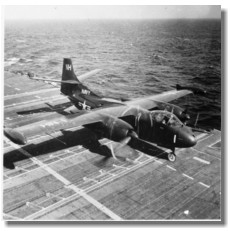
|
CDR McConnell, skipper of VC-7 is seen in the above photo (on February 1952) making his first deck-run
take-off from the wooden straight deck of the USS Wasp. This was being done while the ship was operating off Jacksonville,
Florida, for the sole purpose of qualifying the VC-7 pilots in landing and take off's doing 20 landings each.
Shown here is the AJ-1 using only 2 of its 3 engines with full power following a special white line
on the deck, which was necessarily quite a bit off from the broad white centerline and far enough from the island
to make sure the right wing tip tank of the plane would clear all of that structure on the port side of the island
just aft of the bridge. Also note that the right side of the nose-wheel and tire is painted white to make sure
the caster-type nose-wheel is turned the right way for take off. It might have been disastrous if the nose wheel
had been accidentally left pointing the other way.

The Untold Story
The untold story is that this plane and the whole squadron had the capability to take off from an
aircraft carrier this way carrying the 10,000 pound Mark 6 nuclear weapon. When carrying this load it would be
using the J-33 jet engine in the tail for the extra power needed to lift it into the air and, of course, the pilots
all hoped that the carrier would be up to speed to provide more wind over the deck to assist in this heavy load
take-off.
The rest of the story behind this photo is that when deployed in the Med, this squadron would be
flying from the USS Coral Sea CVB-43, which was quite a bit larger than the Wasp; however the take-off and landing
situation for the AJ-1 was the same on both carriers. The main difference was that the Coral Sea, when required,
was equipped to load the AJ with the large 10,000 pound bomb. The Coral Sea, then in the Sixth Fleet had the capability
to launch a Heavy Attack strike against potential targets.
U.S.S. Coral Sea CVB-43 as it appeared while she still had
the straight deck.

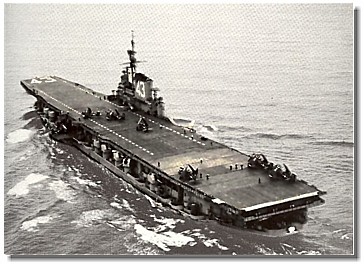 |
The above photo of the Coral Sea CVB-43 has been borrowed from FLAT-TOPS AND FLEDGLINGS by Gareth
L. Pawlowski, specifically to show how the USS Coral Sea appeared while she still had the straight deck. This is
the way she appeared during the summer of 1952 while she was operating with the Sixth Fleet, and when our squadron
of six AJ-1 "Savage" Heavy attack aircraft conducted special operations aboard her.
Later that same year, on October 1, 1952, the designation of the Coral Sea was changed form CVB-43
to CVA-43 and on April 15, 1956 she entered Bremerton Naval Shipyard and was decommissioned nine days later to
have her angled deck and steam cats installed along with other modifications. Thanks to Glen L. Pawlowski from
his book FLAT-TOPS AND FLEDGLINGS.
When VC-7 was getting ready to deploy, I was promoted to Lieutenant Commander and some officer senior
to me were being reassigned. This made me the sixth senior AJ qualified pilot in the squadron and in line to become
the sixth crew commander.
At that time our skipper, Commander McConnell came to me and told me that he was giving me that plane
and crew but that he could not give me a person who was also trained as a Bombardier, Navigator or as a Weaponier.
But he could give me a good pilot just out of training who could fly an airplane and that was all. In fact he had
not had special training of any kind.
He said "I know that you have the best record as a Bombardier/ Navigator (BN) with the top scores
and some how I know that I can expect Crew-Six will continue to get top scores and if required Crew-Six can be
depended on to deliver on target as well as any of the other crews."
To me this meant that in actual practice I was going to be making the take offs and landings and
when on a mission I was going to have to use my new Pilot like I would an auto pilot and have him do the flying
from the left seat while I used the radar and bomb site equipment to navigate and drop weapons if required. On
a war mission, we would be carrying the Mark Six 10,000 pound bomb, At the proper time and while in route to the
target, I was the one to carry out the duties of the weaponier as I had been through weaponier school and was currently
qualified to enter the bomb-bay, and perform a very precise operation on the front end of the bomb inserting the
active material into the pit of the bomb and in making it ready to drop and then I would return to my seat in the
right side and continue navigating and use the bomb sight to make the drop. The tricky part is that, if we actually
had to make a live drop, I was going to have to depend on my young untrained pilot to make the critical break-away
maneuver which was designed to minimize the possibility of being damaged by the effects of our own bomb. After
that, I should be able to return to the left seat and fly the plane back to our carrier and make the landing.
This then is the huge bag of responsibility the skipper put on my shoulders when he gave me command
of Crew-Six.

I had always dreaded the thought of having to ride in the right seat of an AJ while another pilot
made the landings on the carrier. Most of all I feared having to ride aboard with one of our former patrol plane
pilots while he was trying to make his first carrier landings.
Sure enough - it came to pass that I was scheduled to go aboard with a senior x-patrol pilot, and
ride as a passenger, while he made his qualification landings. Not only that, but he happened to be my boss in
the squadron organization so I was advised to be vary careful what I said.
This gent was a great guy and all that, but he just was not a carrier pilot. After he had trouble
on his first two tries at landing, the LSO called him and suggested that he change seats with "Hersch"
Pahl and observe, while I did some of my required refresher landings. That was good news for me so we changed seats
and to top it all off, our plane was the only plane in the traffic pattern. To save time rather than making the
usual right turn after take-off, I suggested that I be allowed to make a left turn off the Bow and turn around
directly to the down-wind leg and on to the final approach or "groove" for another "cut" from
the LSO and landing. With this abbreviated pattern, I made 20 landings and takeoffs in a row with out a single
wave-off, before running low on fuel.
The next planes and fresh pilots were just arriving from Jax, so I was well pleased when I was directed
to return to Jax.
As I departed the area I received personal complement from the ship's Captain for putting on a real
professional show for them. My boss, the x-patrol plane pilot just sat there and didn't say a word all the way
back to Jax.
The flight riding in the right seat must have done my boss a lot of good, as later in the day he
was successful in landing the AJ on the Wasp enough times to qualify.
The VC-7 maintenance officer and pilot, Sid Baney with his
Bombardier-Navigator (BN), Bill Holcombe, USMC and two civilian North American Aircraft Cooperation Technical Representatives.
Taken at Jax Feb 1952.

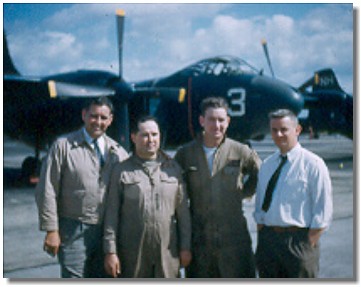 |
Radioman third, Ron Dickman, my Radioman and "fix anything"
man at Jax, Feb 1953.

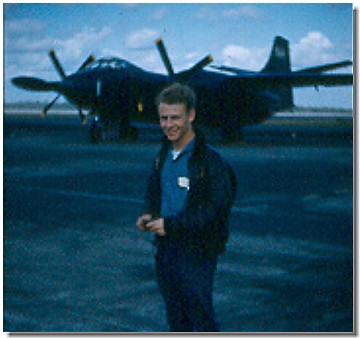 |
The movement of our squadron from Norfolk to Port Lyautey, French Morocco, took place in mid April,
'52. In our agreement with the French, the arrival of our squadron was not to take place before another squadron,
VC-6, departed - so it had to be a well coordinated movement.
Departure
I know that it was foolish to allow my family to be near the runway, but there they were waving to
us as I turned up all three engines including the one J-33 booster Jet engine in the tail and headed down the east
west runway for takeoff. This was my first takeoff carrying a full load of fuel. It was early in the morning on
12 April 1952. The air was crisp and the humidity was high, so I had good thrust and the power I needed to make
a good takeoff.
We made our departure from NAS Norfolk and flew via Bermuda and the Portuguese Azore Islands. I flew
AJ-1 Number 6, with two crewmen (an enlisted mechanic and an ordnance man who had learned to operate the radar).
In the big bomb bay of the plane a big hammock type flexible fuel tank was installed. I don't recall how much fuel
it held when full, but it occupied the whole bomb bay where we could carry a 10,000 pound bomb. In other words
we were pretty heavy.
Once air-born, I took up a course directly toward Bermuda. All planes joined in a loose formation
in route. My regular copilot, Don Jessen, was flying with Curt Sprague, in one of the P2V-3Cs. In theory the P2Vs
were supposed to be doing the navigation and leading the other six AJ-1s to our destination; however, I had learned
long ago that when I was in the air I had very little respect for the navigation done by anyone else, so as usual
I did my own.
The young Pahl family that had to give up their Daddy for
a few months while he flew away across the ocean for duty in Africa and the Mediterranean Sea. Mother Bonnie is
holding Dale (1 ½ ) with Randy (7 ½) on her right and Neel (3+) on her left.
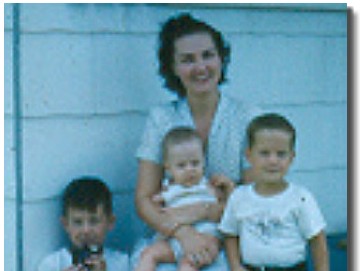
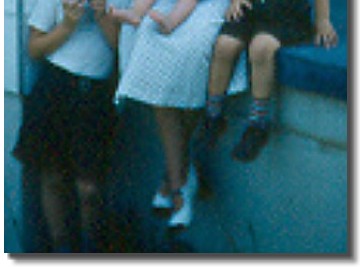 |
Fuel Management
In our management of fuel, as one would expect, we used the fuel from the big tank in the bomb bay
first and the fuel from our auxiliary tip tanks next. The trip to Bermuda took only 3.6 hours, so we still had
quite a bit of fuel and were quite heavy when we landed.
Bermuda
In Bermuda, we experienced the British way of driving on the left side of the road and observed the
100% defoliation of trees, which had recently been caused by insects. We stayed a couple nights while some minor
maintenance work was being done on my airplane. We had an indication that the fuel from my tip tanks was not transferring
as it should. Believing the trouble had been fixed we took off for the Azores early on the 14th of April. One of
the P2V's and most of the AJ's had gone on the day before.
Trouble
When we were about 5 or 6 hours into the flight it became apparent that the tip tanks were not going
to empty correctly and that fuel might not be available for use. When my internal fuel was partially used up, it
became obvious I was going to need that tip tank fuel to make it to Lages, the only air field in the Azores, and
there were no alternates.
It seemed like a stupid maneuver but after experimenting a bit, I found that by flying with one wing
down in a nose up skid maneuver, I could cause fuel to flow by gravity down hill into the main tanks. It took more
power to keep up with the rest of the flight but it worked well enough so that I did not exhaust my fuel supply
before I arrived at the Lages Airport, ending a 9.5 hour stint in one seat. Yes, I had a bad case of "TB"
when we arrived.
When we were about 5 or 6 hours into the flight it became
apparent that the tip tanks were not going to empty correctly and that fuel might not be available for use. When
my internal fuel was partially used up, it became obvious I was going to need that tip tank fuel to make it to
Lages, the only air field in the Azores, and there were no alternates.
Lages Field in Azores - Oct '52
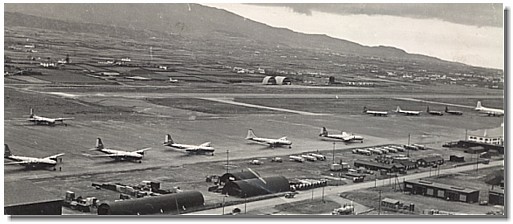 |
From Lages to Port Lyautey
After a night at Lages, we proceeded to fly 5.7 hours on over to French Morocco. We landed on Port
Lyautey's rough old runway, which the Germans built during the early part or WWII.
This runway was a part of a French Air Base, so we shared the field with a French squadron of 4 engine
bombers or patrol planes (?). The U.S. Navy also operated a squadron of ELINT planes.
French Heavy bomber at Port Lyautey 1952.
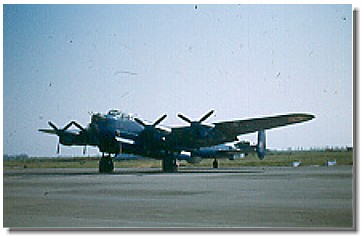 |
For our benefit, the French tower operator spoke some English and in time we began to understand
a little French. Therefore, we were able to get along okay with traffic control at the filed. I was fortunate that
my copilot, Don Jessen. could speak and understand a little more French than I could.
This was to be our training and staging base for fleet operations when directed for operations some
distance north in the Mediterranean Sea aboard the aircraft carrier USS Coral Sea and the USS Wasp.
Pictured is a Stork on his nest on rooftop near the field
at Port Lyautey French Morocco.
 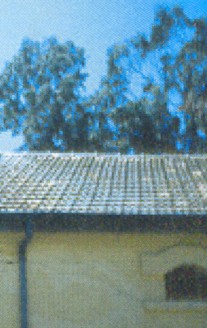 |
This Story (#3) of Composite Seven (VC-7)
Deployment to the Mediterranean Continues
in Stories # 4 thru 8
- Hersch Pahl
|